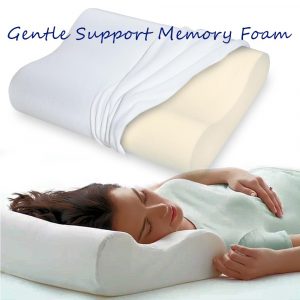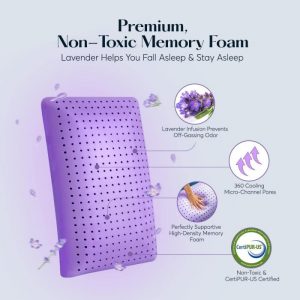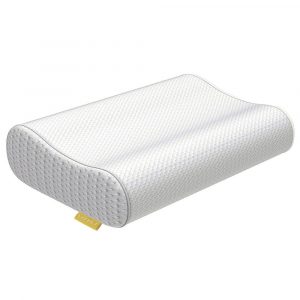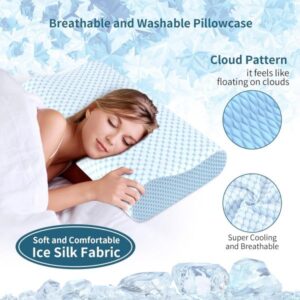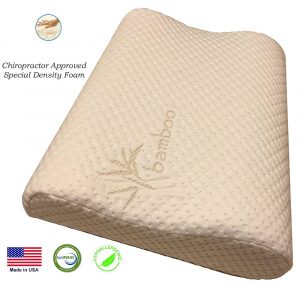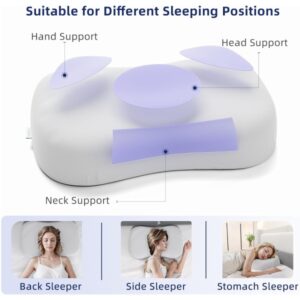Your Guide To Quality Memory Foam Pillows For Lasting Support, Better Health & Comfort
Memory foam pillows offer a unique material based on the properties of its cell structure. Unlike standard foam pillows that only partially compress when under pressure, the cells in memory foam pillows fully compress when the weight of the head is pressed upon it, then the pillow springs back to it’s original shape very slowly.
This is how the name “memory foam” came to be, the foam appears to remember the shape of your head when it was last placed upon it’s surface. The slow pillow recovery plays a major role in the memory foam therapeutic properties. These pillows will mold to the head and neck and hold the shape as long as the weight remains pressed on it which reduces pressure points on the neck and head
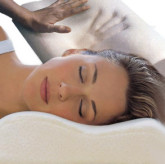 They are also temperature sensitive. This means that at lower temperatures it is harder and more viscous, while at higher temperatures, it is softer and more elastic. This is they are called visco-elastic. The temperature sensitive quality gives the melting feeling as your head slowly sinks into a memory pillow. The reaction to your head and neck temperature (softening with heat) allows it to more easily adjust to head and neck contours with a custom molding affect.
They are also temperature sensitive. This means that at lower temperatures it is harder and more viscous, while at higher temperatures, it is softer and more elastic. This is they are called visco-elastic. The temperature sensitive quality gives the melting feeling as your head slowly sinks into a memory pillow. The reaction to your head and neck temperature (softening with heat) allows it to more easily adjust to head and neck contours with a custom molding affect.
The memory foam’s capacity to redistribute weight and surface reduces pressure between the skin and bony areas of the head, face, jaw, ear and neck. If pressure is not relieved, the body will do it through movement to prevent blood vessel compression and inhibition of circulation and possibly irritating the skin tissue. This is a possible reason why some people “toss and turn” at night to try and get comfortable.
The quality of a memory foam is measured by its density. The denser the memory foam, the heavier and firmer it is to the touch. The denser pillows usually take longer to recover from a compression and are more supportive than less dense memory foam pillows. Because of slower recovery and increased support, denser memory foam is often more expensive due to the higher manufacturing and fabrication costs.
 Density alone will not tell you everything you need to know about the feel or comfort of a memory foam. Density simply tells you how much a particular piece of the foam weighs. A four pound density means that a one foot cube of the pillow would weigh four pounds. Each brand has its own unique feel and recovery time. Higher density memory foam pillows tend to have more of the unique memory feel that makes the foam more supportive. A two pound density memory foam pillow lacks enough density to give you the same feel and support that you get from a four or five pound density pillow.
Density alone will not tell you everything you need to know about the feel or comfort of a memory foam. Density simply tells you how much a particular piece of the foam weighs. A four pound density means that a one foot cube of the pillow would weigh four pounds. Each brand has its own unique feel and recovery time. Higher density memory foam pillows tend to have more of the unique memory feel that makes the foam more supportive. A two pound density memory foam pillow lacks enough density to give you the same feel and support that you get from a four or five pound density pillow.
Originally developed by NASA engineers in the late 1970’s, memory foam was designed for pressure relief during space travel. After its development memory foam was used by the medical industry for its therapeutic properties. During the early 1990’s, it was first introduced to the consumer for bedding and pillows. Since then, memory foam has become one of the most popular pillow and sleep surfaces. It is promoted by chiropractors, sports therapists, and even world renowned athletes for its therapeutic and unique molding characteristics.
Today, many variations are manufactured in various locations around the world. Because there are so many variations, it is very important to trust a manufacturer before purchasing memory foam pillow online. There has been a dramatic increase in low quality memory foam pillow imports from foreign manufacturers.
Memory foam pillows differ dramatically in quality, density, hardness or softness, response to temperature, as well as in durability.
The first company to produce memory foam pillows was TempurPedic. TempurPedic developed a manufacturing process that involves pouring the memory foam, while it’s still in its liquid form, into pillow molds. Because TempurPedic utilizes a pouring process, their pillows are denser than many. The pouring process is also expensive and the prices reflect this. Since merging with another company, their pillows are too dense – hard, and have a chemical smell that can be quite offensive. It appears they have worked out some of these issues – do your research.
- A 2019 study in Health SA found the addition of a memory foam pillow resulted in reduced neck pain and disability beyond the standard course of chiropractic treatment. Pain improved 73% compared to the 43% and disability reduced 79% compared to 59%, by the addition of the pillow.
The authors state, “It should also be noted that improved sleep quality not only decreases waking pain, in itself, but also results in an improved secretion of growth hormone during sleep, which further facilitates tissue repair” They postulated the benefits from maintaining a more ideal sleeping posture, improved tissue repair around and in the facet joints, decrease in muscular tension, and better sleep quality with chronic neck pain.
Many new pillows, while slightly less dense and temperature sensitive, provide a great supportive and comfortable pillow at a more economical price so that more people can afford the benefits of quality memory pillows.


